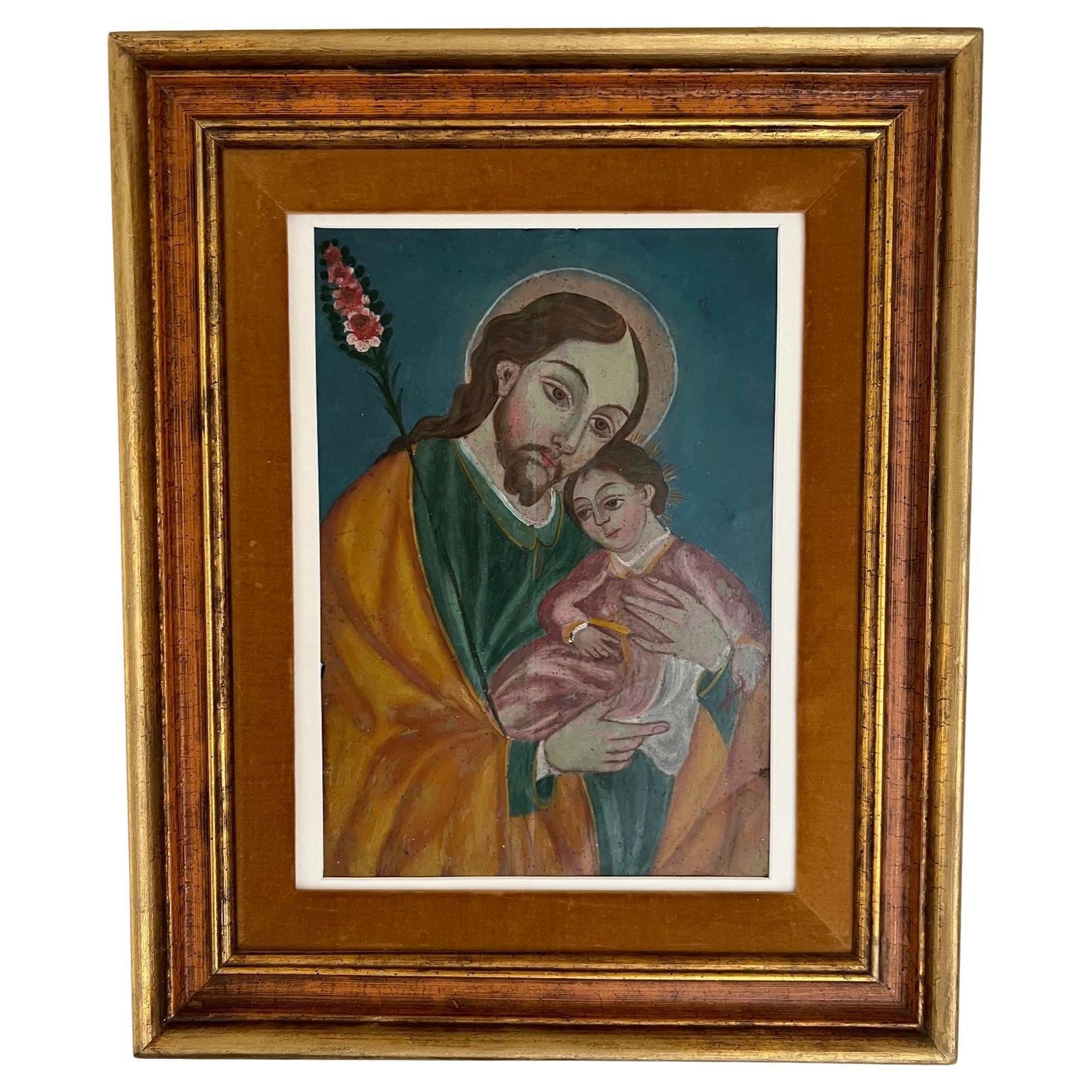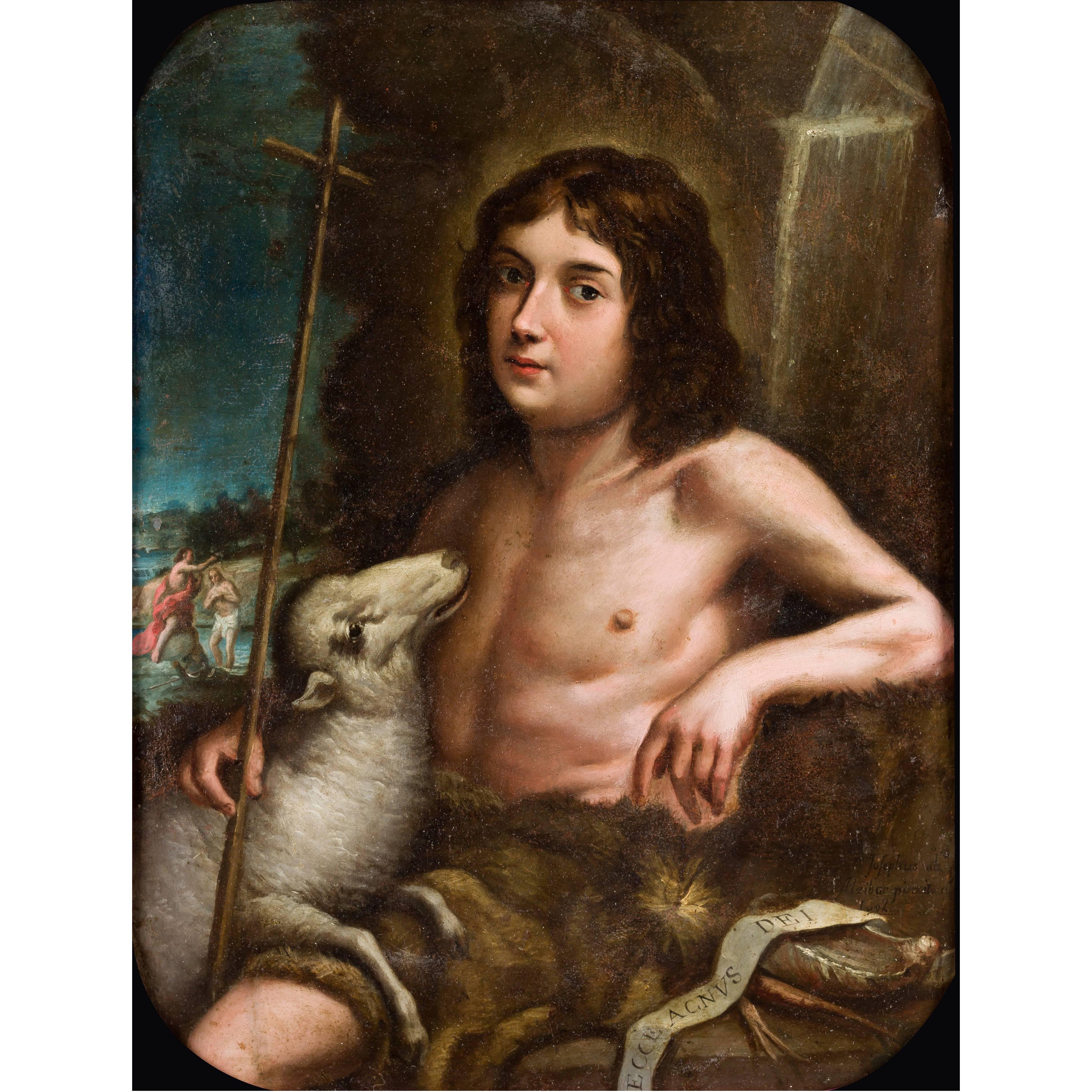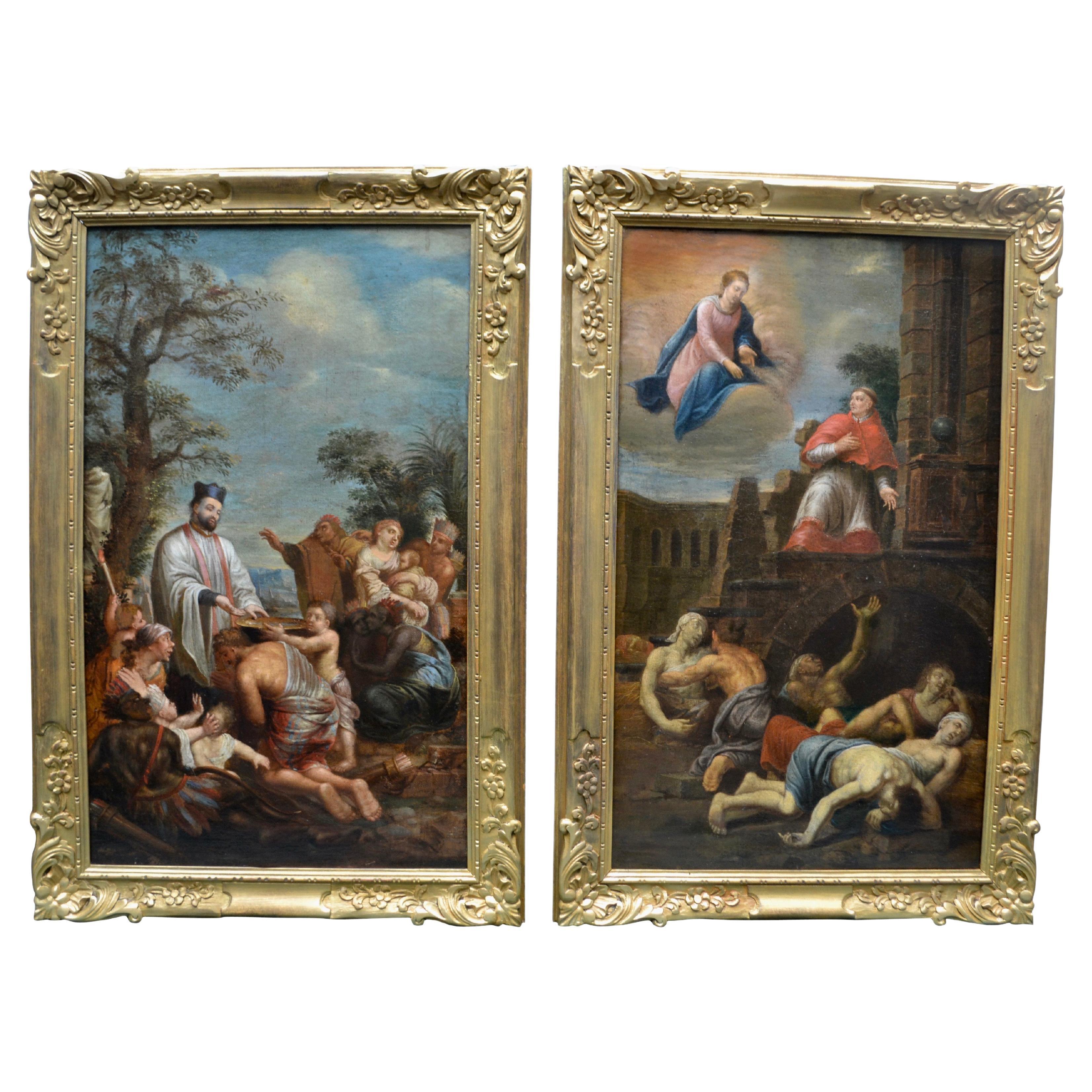Items Similar to St Hedwig
Want more images or videos?
Request additional images or videos from the seller
1 of 2
St Hedwig
About the Item
This 19th century Mexican oil on tin 'oracion' (prayer) is dedicated to Santa Eduviges. Saint Hedwig is the patroness saint of Bavaria, brides, jealousy and difficult marriages -- known mostly for her generosity, bestowing all that she could give to the sick, the feeble, the impoverished and the imprisoned. In this image she is flanked by two young men, devoting her riches to a group of indigents at the gates of prison. The prayer, written in her honor, was offered by one of her many beneficiaries in commemoration of her good will.
- Dimensions:Height: 14 in (35.56 cm)Width: 10 in (25.4 cm)Depth: 0.1 in (2.54 mm)
- Style:Spanish Colonial (Of the Period)
- Place of Origin:
- Period:
- Date of Manufacture:19th Century
- Condition:Minor losses.
- Seller Location:Mexico, MX
- Reference Number:1stDibs: LU319619190561
About the Seller
No Reviews Yet
Vetted Seller
These experienced sellers undergo a comprehensive evaluation by our team of in-house experts.
1stDibs seller since 2017
- ShippingRetrieving quote...Ships From: Mexico, Mexico
- Return PolicyA return for this item may be initiated within 7 days of delivery.
More From This SellerView All
- St John the BaptistLocated in Mexico, DFJose de Alcibar, infant Saint John, signed and dated 1802, oil on copper. This item does not belong to the mexican heritage as it has been acquired and...Category
Antique Early 19th Century North American Spanish Colonial Paintings
- Spanish Colonial ScreenLocated in Mexico, DFFantastic Spanish Colonial school screen. Probably from Peru. This screen, with a kind of European landscape, give us an idea of the influence ...Category
Antique 18th Century Peruvian Spanish Colonial Paintings
- "Saint Ferrer", Oil on TinLocated in Mexico, DFA 19th century oil on tin folk retablo San Vicente Ferrer, a Dominican Friar who traveled 21 straight years spreading his faith as a missionary. Saint Vince...Category
Antique Early 19th Century North American Spanish Colonial Paintings
- Virgin of Guadalupe, Oil on Copper, 18th CenturyLocated in Mexico, DFVirgin of Guadalupe with flowers and appearances of the Virgin to Juan Diego, oil on copper, 18th century. This item does not belong to the mexican...Category
Antique Early 18th Century North American Spanish Colonial Paintings
MaterialsOther
- San CamiloLocated in Mexico, DFThis 19th century oil on tin folk retablo represents 'San Camilo de Lelis', often referred to as the 'Red Cross Saint' -- a reference to the Red Cross worn on his black habit. San C...Category
Antique Early 19th Century North American Spanish Colonial Paintings
MaterialsOther
- 18th Century Painting, Our Lady of the "Goodhelp" with SaintsLocated in Mexico, DFSpanish colonial Mexican school 18th century Oil on canvas Measures: 177 x 11 cms.Category
Antique Mid-18th Century North American Paintings
You May Also Like
- Genre Painting of Men Conversing by Hedwig Oehring (German, 1855-1907)Located in Shippensburg, PAGENRE PAINTING OF MEN CONVERSING OVER A PINT BY HEDWIG OEHRING (GERMANY, 1855-1907) Signed "H. Oehring / Munchen" lower left; in oil on panel; partial label verso "636" Item # 012NPP...Category
Antique 19th Century German Romantic Paintings
MaterialsPaint
- 19th Century Framed Retablo of St. JosephLocated in Ross, CAAntique retablo showing Saint Joseph with a child Jesus. Vibrantly painted in rich turquoise and burnt orange colors. Matted in cream and velvet in a v...Category
Antique Late 19th Century Mexican Spanish Colonial Paintings
MaterialsTin
- Pair of 18 Century Paintings of St Francis Xavier and St Carlo BorromeoLocated in Vancouver, British ColumbiaA beautifully executed and rare complementary pair of oil on canvas paintings depicting two of the moist famous and important counter reformation catholic saints St Francis Xavier and St Carlo Borromeo shown in scenes of what the respective saints are mostly famous for. St Francis Xavier for the conversion to Christianity of many S. E Asian countries notably India and St Carlo Borromeo shown asking the Virgin Mary to intercede for the cessation of the terrible plague of 1576. The paintings are presented in refreshed gilded carved wooden frames and are unsigned. St. Francis Xavier was born in Spanish Navarre in 1506 and in 1528, he met St. Ignatius of Loyola. He became one of the seven in 1534 who founded the Society of Jesus (Jesuit Order). In 1536, he left the University of Paris and joined St. Ignatius in Venice. He was ordained in 1537, and in 1540 after the Society was recognized by the Pope, he journeyed to the Far East. Francis Xavier first evangelized the Portuguese colony of Goa in India, then Travancore, Ceylon, Malacca, and the surrounding islands. From there he journeyed to Japan, where he gave Christianity such deep roots that it survived centuries of violent persecution. He died on Sancian Island in 1552, while he was seeking to penetrate into the great forbidden land of China. Despite language problems, lack of funds, resistance from the Europeans as well as the natives, he persevered. St. Francis converted more people in his life than anyone since the Apostle St. Paul. He baptized over 3 million people, converted the entire town of Goa in India, and he labored in India, Pakistan, Bangladesh, Sri Lanka, Malaysia, Indonesia, Singapore, and Japan. He was truly a missionary par excellence. St Carlo Borromeo (1538-1584), was a Cardinal of the Holy Roman Catholic Church and Archbishop of Milan from 1565 to 1583. He was described in the decree for his canonization, as “a man, even while the world smiles on him with the utmost flattery, he lives crucified to the world, spiritually, trampling earthly things, seeking continuously the things of heaven, emulating the life of the Angels on earth, in his thoughts and actions. The plague began in the month of August that year. Milan was celebrating joyfully the arrival of Don John of Austria, on his way to Flanders, where he had been appointed governor. The city authorities were abuzz with excitement in their desire to bestow the highest honours on the Spanish prince, but Charles, who had been Archbishop of the diocese for six years, was following with concern the news coming from Trento, Verona and Mantua, where the plague had begun claiming victims. The first cases exploded in Milan on August 11th, right at the moment when Don John of Austria arrived. The victor of Lepanto, followed by the governor, Antonio de Guzmán y Zuñiga, departed the city, while Carlo Borromeo, who was in Lodi for the Bishop’s funeral, returned in haste. Confusion and fear reigned in Milan and the Archbishop dedicated himself completely to assisting the sick and ordering public and private prayers. Dom Prosper Guéranger sums up his infinite charity in this way: “In the absence of local authorities, he organized the health service, founded or renewed hospitals, sought money and provisions, decreed preventive measures. Most importantly though, he took steps to ensure spiritual help, assistance to the sick and the burial of the dead. Unafraid of being infected, he paid in person, by visiting hospitals, leading penitential processions, being everything to everyone, like a father and true shepherd” St. Carlo was convinced that the epidemic was “a scourge sent by Heaven” as chastisement for the sins of the people and that recourse to spiritual measures was necessary to fight against it: prayer and penitence. He rebuked the civil authorities for having placed their trust in human measures rather than divine ones. “Hadn’t they prohibited all the pious gatherings and processions during the time of the Jubilee? For him, and he was convinced of it, these were the causes of the chastisement. The magistrates who governed the city continued to oppose public ceremonies, out of fear that the large gathering of people would spread contagion, but Charles “who was guided by the Divine Spirit” – recounts another biographer – convinced them by citing various examples, among which was the one regarding St. Gregory the Great who had halted the plague devastating Rome in 590. While the pestilence spread, the Archbishop then ordered three general processions to take place in Milan on the 3rd, 5th and 6th of October, “to placate the wrath of God”. On the first day, the Saint, despite it not being the Lenten season, placed ashes on the heads of the thousands gathered, exhorting them to penitence. Once the ceremony was over, the procession went to the Basilica of St. Ambrose. Charles put himself at the head of the people, dressed in a hooded purple robe, barefoot, penitential cord at his neck and large cross in his hand. The second procession led by the Cardinal headed towards the Basilica of San Lorenzo. The third day the procession from the Duomo headed for the Basilica of Santa Maria at San Celso. St. Carlo carried in his hands a relique of Our Lord’s Holy Nail, which had been given by the Emperor Theodosius to St. Ambrose in the 5th century. The plague didn’t show any signs of waning and Milan appeared depopulated, as a third of its citizens had lost their lives and the others were in quarantine or didn’t dare leave their homes. The Archbishop ordered about twenty stone columns with a cross at the top to be erected in the main squares and city crossroads, allowing the inhabitants from every quarter to take part in the Masses and public prayers - from the windows of their homes. One of Milan’s protectors was St. Sebastian, the martyr the Romans had recourse to during the plague in 672. St. Charles suggested that the magistrates of Milan reconstruct the sanctuary dedicated to him, which was falling into ruins, and to celebrate a solemn feast in his honour for ten years. Finally in July 1577, the plague ceased and in September the founding stone was laid in the civic temple of St. Sebastian, where on January 20th every year, even today a Mass is offered to recall the end of the scourge. St.Carlo Borromeo died on November 3rd 1584 and was buried in the Duomo of Milan. His heart was solemnly translated to Rome, in the Basilica of Saints Ambrose...Category
Antique Late 18th Century French Baroque Paintings
MaterialsCanvas
- Spanish Colonial Cuzco School 18th C. Oil on Canvas St. Joseph with Christ ChildLocated in Bradenton, FL18th century oil on canvas, St. Joseph with Christ child. The unidentified artist who painted this bucolic scene, dominated by the figure of the sixteenth-century Portuguese monk Sa...Category
Antique 18th Century Peruvian Spanish Colonial Paintings
MaterialsCanvas
- 21st Century Contemporary Art Wall PaintingLocated in Los Angeles, CAThis extraordinary contemporary wall painting has been remarkably executed on canvas. This remarkable painting is inspired by a nostalgic mystery woman in the artist's life. The arti...Category
21st Century and Contemporary French Modern Paintings
MaterialsCanvas, Wood, Paint
- Late 19th C. Eastern European Icon of St. GregoryLocated in San Francisco, CALate 19th C. Eastern European Icon of St. Gregory. Painted on a panel composed of two boards joined together with two battens, top and bottom. The wood appears to be either pine or f...Category
Antique 1890s Balkan Balkan Paintings
MaterialsGold
Recently Viewed
View AllMore Ways To Browse
Mexican Spanish Colonial Furniture
Mexico Tin
Mexican Tin
Saint In Prayer
Oil On Tin Mexican
Santa Tin
Antique Santa Tin
Retro Dressing Table Mirror
The Marketplace Used Furniture
Art Deco Bar Brass And Glass
19th Tall Chests
Painted Flowers On Gold Leaf
Low Bed
Scandinavian Office Chairs And Desk Chairs
Vintage Dresser Drawers With Mirror
White Louis Xvi Chairs
Vintage Kitchen Dresser Furniture
Antique State Flags





